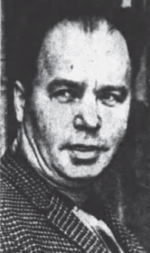 The Anniston Star (Anniston, TX), January 26, 1971 On January 4, 1961, two men entered the grocery store owned by 57-year-old grocer Morris Hasson in Los Angeles, California. One of the men pulled a gun on Hasson while the other spoke to Hasson’s wife. The man with the gun fired a shot and killed Hasson, and the two perpetrators then fled the store. Police viewed the crime as a holdup-murder and found no viable suspects until January 15, 1961, when 44-year-old Paul Kern Imbler turned himself into police for the separate robbery attempt of a service station in Pomona. Imbler and another man had aborted their service station robbery attempt, fleeing the scene in a truck, which flipped over and killed Imbler’s accomplice. Imbler had escaped on foot and turned himself into authorities the next day. During a police line-up, several witnesses to the Hasson murder identified Imbler. However, it was later learned that there were circumstances that had materially influenced their identification of Imbler. The most promising witness for the prosecution was Alfred Costello, who was later found to have expected compensation from the victim’s wife for his testimony. Imbler was convicted on the second-degree robbery charge (Pomona) and sentenced to one year to life in prison on February 6, 1961. He was then tried for Hasson’s murder on July 7, 1961. Imbler was convicted on assault and murder charges on July 19, 1961, and sentenced to death by Los Angeles Superior Court Judge Mark Brandler on August 10, 1961. Justice Roger Traynor affirmed the conviction when it reached the California Supreme Court on automatic appeal. Imbler then contacted Dr. Leonard Snyder, a member of the Michigan State Bar, who began researching the case. Snyder contacted Ed Montgomery, a Journalist from the San-Francisco Examiner. Together they found a plethora of exculpatory evidence. A jacket and hat had been left at the scene of the crime by the assailant, both of which were too small for Imbler, though witnesses had said the garments hung loosely on the perpetrator. Found inside the jacket were the murder weapon and a razor blade casing, which contained a full fingerprint that did not belong to Imbler. Snyder discovered that Hasson had also been running a loan sharking business out of his grocery store, as well as a gambling racket. The state’s prime witness, Costello was discovered to be a runner for Hasson’s bookie business. Costello had also lied about his credentials, background and employment. Snyder also discovered that the so-called robber had not demanded money at the time of the shooting. Based on what he found, Snyder filed an affidavit with the State Supreme Court, which then granted a stay allowing an evidentiary hearing held in Los Angeles before Justice Thomas White, who sustained the conviction. With help from Snyder and Montgomery, Gregory Stout, Imbler’s court-appointed defense attorney, then forwarded a petition on Imbler’s behalf for a writ of certiorari to the United States Supreme Court, where Justice Douglas granted another stay of execution. In November 1968, Imbler filed a petition for habeas corpus based on the advice of Dr. Snyder, which was then denied. Shortly thereafter, attorney Roger S. Hanson of Stanford University Law School took over the case and filed an appeal to the United States Circuit Court of Appeals in San Francisco, which ordered the case transferred to Los Angeles for a hearing before Federal District Judge Ferguson. Judge Ferguson handed down his opinion in January 1971, granting the writ of habeas corpus and ordering the State to either retry Imbler within sixty days or allow him to go free. In his legal opinion, the judge scalded the District Attorney who had allowed Costello to testify that he had college degrees and had been working as a refrigeration engineer for several years, when he was actually a runner for Hasson’s bookie business with a four page FBI rap sheet. The State held Imbler on the second-degree murder charge as the Attorney General attempted to appeal but failed, and then exhausted every venue for a reversal of the Federal Judge’s decision. With help from Montgomery, the process was sped up so that finally –3,720 days after turning himself in for the Pomona robbery – the charges against Imbler were dropped and he was set free. Imbler filed a $2.7 million civil suit against prosecuting attorney Richard Pachtman, alleging that Pachtman had engaged in a conspiracy to wrongfully convict him while suppressing exculpatory evidence. Imbler’s lawsuit was ultimately thrown out by the U.S. Supreme Court in 1976, with Justice Lewis F. Powell Jr. writing that requiring prosecutors to defend themselves against charges of wrongdoing would impose a “unique and intolerable” burden on the prosecutors. – Researched by Patrick Aranza
|